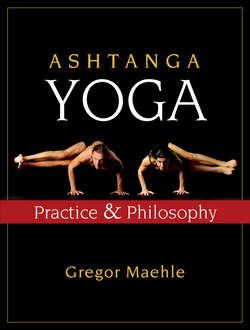Читать книгу Ashtanga Yoga - Gregor Maehle - Страница 27
На сайте Литреса книга снята с продажи.
Temperature
ОглавлениеIf you practice in a hot country, you will heat up quickly. This is especially true of males. Care needs to be taken not to overheat if one is engaging in strenuous practice in a hot environment. As with any type of engine, so also with the human body: overheating is not good. Sweating is healthy, but if sweat drips from the body it is a sign that the body is no longer able to cool itself adequately. Sweating to this degree on a daily basis literally drains life force from the body. A temperature of 68°F would be ideal for practice, with a range of 15° below and above that still possible, but practice speed needs to be adapted — faster when it’s cold to increase heat and slower when it’s hot to cool down. On a hot day, focus on the cooling quality of the breath.
Heating the yoga room to above 77° may produce more flexibility, but it decreases strength, stamina, and concentration. If yoga were only about flexibility, contortionists would be the greatest yogis. It is worth noting that extreme flexibility is often a result of biochemical imbalance. True posture is about the ability to focus deeply within.
The Ashtanga Vinyasa practice attempts to balance flexibility with strength. Real yoga “will walk the edge between opposing extremes.”3 Rather than desperately cranking ourselves into one particular direction in a posture, we expand simultaneously in all directions. The first pair of opposites that we discover in physical yoga is strength/flexibility. Excess flexibility is an obstacle because it means loss of strength and vice versa. We should never build up a degree of flexibility that is not matched by the necessary support strength. On the other hand, building up great strength without increasing one’s flexibility restricts the range of joint movement.
A heated yoga room helps flexibility because it increases vata and pitta. A cold yoga room helps strength because it increases kapha.4 A cold room also increases awareness and attention to detail. We have to study the posture more deeply to get to the same point in a cold room, but this pays off in terms of benefits. There is more learning if the temperature is low, and the body becomes sturdier due to the awakening of physical intelligence. We can avoid this process by turning up the thermostat, but everybody who has worked through a couple of winters with only moderate heating values the gain in refinement that it brings.
If temperatures are high, proper ventilation is necessary. The western fashion of keeping all windows closed in sweltering temperatures so that you can see puddles of sweat on the floor is surprising, considering that I have never seen a yoga room in India that even had closeable windows. The Hatha Yoga Pradipika warns in several places of the dangers of too much heat and too much heating, by staying too close to the fire for example, and also of excess physical exertion. Getting too cold, for instance by taking cold morning baths, is also not recommended. The idea here is moderation: staying away from the extremes and abiding in the center. Once a yogi is fully established, however, extremes will no longer be of concern.
